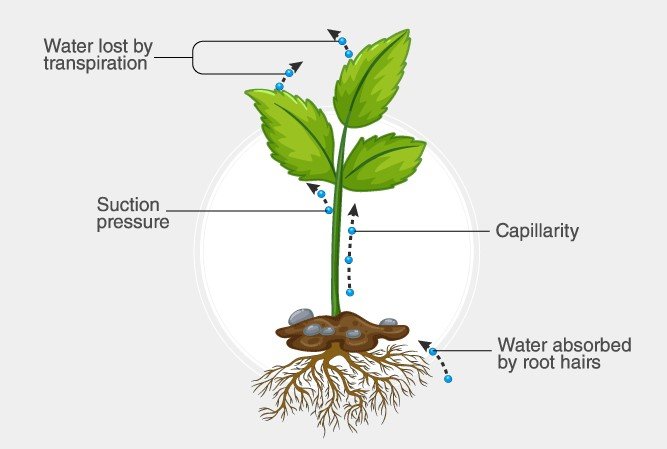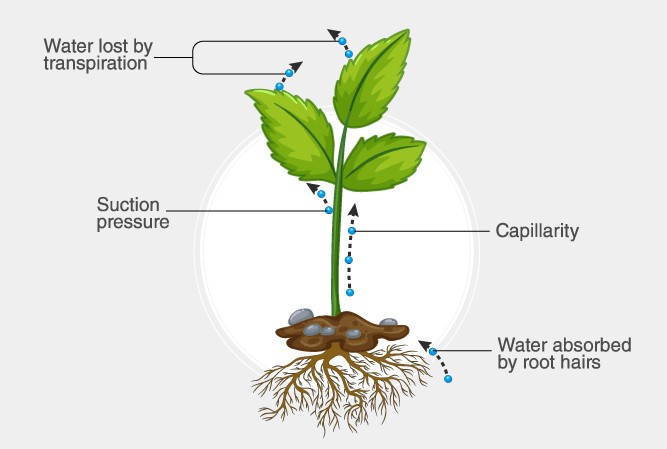The lifeblood of a plant’s existence is its ability to move water from the soil through its roots to the rest of its structure, reaching as far as the leaves that dance in the sunlight. This remarkable journey of water is facilitated by two primary mechanisms: root pressure and transpiration pull. Both play pivotal roles in a plant’s water transport system but operate through distinctly different processes and under different conditions.
Root pressure and transpiration pull are fundamental in driving water movement in plants. Root pressure is a phenomenon where water is pushed upwards from the roots due to water absorption, primarily effective during the night or in small plants. In contrast, transpiration pull relies on the evaporation of water from leaves, creating a negative pressure that draws water up through the plant’s xylem, and is most significant in larger plants during the daytime.
Focusing on the topic, root pressure provides a gentle push of water from the roots when environmental conditions slow down transpiration, playing a crucial role during the early growth stages of a plant or in moist conditions. On the other hand, transpiration pull, leveraging the cohesion-tension theory, is the powerhouse behind water movement in mature plants, facilitating not only hydration but also nutrient distribution and temperature regulation through the process of transpiration.

Root Pressure Explained
Definition
Root pressure is a key physiological mechanism in plants, crucial for the upward movement of water. It arises in the roots due to the osmotic pressure generated as water molecules move from the soil into the root cells. This pressure forces water upward through the plant’s vascular system, a process essential for the plant’s hydration and nutrient transport.
Causes
Water and Mineral Uptake
Root pressure develops when the plant’s roots actively absorb water and minerals from the soil. This uptake is driven by the concentration gradient between the mineral-rich water inside the root cells and the relatively mineral-poor water in the soil. As the roots absorb water, the pressure within the roots builds, pushing water upwards.
Nighttime Dynamics
During the night, the absence of sunlight reduces the rate of transpiration, decreasing water loss through the leaves. This reduction in water loss leads to an accumulation of water in the roots, further increasing root pressure. The nighttime dynamics of root pressure are critical for maintaining water movement in the absence of transpiration.
Role in Plants
Early Spring Activity
In early spring, root pressure is particularly important. Before the leaves fully develop and begin transpiration, root pressure helps to move water and nutrients up from the roots to the budding leaves. This early spring activity is crucial for the initial growth phase of plants.
Water Transport in Small Plants
For small plants, root pressure plays a vital role in water transport throughout the plant body. Without the extensive height that requires the transpiration pull mechanism, small plants rely on root pressure to ensure that water reaches all parts of the plant efficiently.
Transpiration Pull Unveiled
Definition
Transpiration pull is another fundamental process in plants, crucial for the transport of water from the roots to the leaves. Unlike root pressure, transpiration pull operates through the evaporation of water from the leaves, creating a negative pressure that draws water up through the xylem.
Mechanism
Cohesion-Tension Theory
The cohesion-tension theory explains how water molecules stick together (cohesion) and to the walls of the xylem vessels (adhesion), facilitating the continuous movement of water from the roots to the leaves. As water evaporates from the leaf surfaces, it pulls the next molecule of water along, creating a continuous stream of water movement.
Stomatal Regulation
The stomata, small openings on the leaf surface, play a key role in regulating transpiration. They open to allow for gas exchange, which inadvertently leads to water loss. The plant regulates these openings to balance the need for carbon dioxide for photosynthesis with minimizing water loss, directly influencing the transpiration pull mechanism.
Role in Plants
Water and Nutrient Distribution
Transpiration pull is essential for the distribution of water and nutrients throughout the plant. This mechanism not only helps in transporting water to the leaves for photosynthesis but also carries dissolved nutrients from the soil to different parts of the plant.
Cooling Effect
Besides hydration and nutrition, transpiration pull has a cooling effect on plants. As water evaporates from the leaf surfaces, it dissipates heat, helping to regulate the plant’s temperature, particularly on hot days.
Comparative Analysis
Process Comparison
Direction of Movement
While both mechanisms aid in the upward movement of water, root pressure is primarily effective in pushing water upwards from the roots. In contrast, transpiration pull draws water up through the plant via a negative pressure generated at the leaves.
Energy Source
Root pressure is driven by osmotic pressure, which is an active process requiring energy from the plant. On the other hand, transpiration pull is a passive process, driven by the physical properties of water and the environmental conditions that promote transpiration.
Impact on Plant Health
Efficiency in Water Transport
Transpiration pull is generally more efficient at transporting water over long distances, making it crucial for tall plants. Root pressure, while important, is less efficient and more suited to shorter distances and smaller plants.
Influence on Growth and Development
Both root pressure and transpiration pull have a significant impact on a plant’s growth and development. Root pressure supports early growth stages and is crucial for plants in moist environments or with limited transpiration. Transpiration pull, however, supports the bulk movement of water necessary for photosynthesis, nutrient transport, and cooling, influencing the overall health and productivity of the plant.

Key Differences Summarized
Root Pressure vs. Transpiration Pull
When exploring the vital mechanisms that plants use for water movement, two primary processes stand out: root pressure and transpiration pull. Although both serve the essential function of transporting water from the roots to the leaves, they operate under different principles and conditions.
Summary Table of Differences
| Feature | Root Pressure | Transpiration Pull |
|---|---|---|
| Mechanism | Osmotic pressure pushes water upwards | Evaporation of water creates a negative pressure |
| Energy Source | Active, requires energy | Passive, driven by physical properties of water |
| Efficiency | More effective in small plants | More efficient in large plants |
| Environmental Impact | Less influenced by external factors | Highly dependent on humidity, temperature, wind |
| Role in Plants | Supports early growth, operates at night | Drives nutrient transport, cooling effect |
Significance in Botany
Understanding the differences between root pressure and transpiration pull has significant practical implications for botany and plant physiology. This knowledge not only aids in the study of plant health and growth but also in agricultural practices, where optimizing water and nutrient delivery can enhance crop yields.
Advantages and Limitations
Root Pressure
Advantages in Nutrient Absorption
Root pressure is crucial for nutrient absorption, especially during the initial stages of growth or in environments where transpiration is minimal. This pressure helps in distributing nutrients evenly throughout the plant, even reaching upward to the younger parts that are yet to participate actively in transpiration.
Limitations in Height and Efficiency
However, root pressure has its limitations. It cannot efficiently transport water to the taller parts of large plants, due to the limited force it can exert. This makes root pressure less effective in tall trees or plants experiencing rapid growth.
Transpiration Pull
Advantages in Large Plants
Transpiration pull shines in its ability to move water over long distances, making it particularly beneficial for large plants. This mechanism supports not only hydration but also plays a key role in nutrient distribution and temperature regulation.
Limitations During Water Stress
The effectiveness of transpiration pull can be significantly reduced during periods of water stress, such as drought. When water is scarce, plants may close their stomata to conserve water, which in turn reduces the transpiration rate and the associated pull, impacting the plant’s ability to transport water and nutrients.
Environmental Influences
On Root Pressure
The effectiveness of root pressure can be influenced by several environmental factors, such as:
- Soil Moisture Levels: Adequate moisture is essential for maintaining osmotic pressure within the roots.
- Nutrient Availability: A higher concentration of nutrients in the soil can enhance root pressure by increasing the osmotic gradient.
On Transpiration Pull
Transpiration pull, being heavily dependent on the process of transpiration, is influenced by:
- Humidity: Lower humidity increases transpiration rate, enhancing transpiration pull.
- Temperature: Higher temperatures can increase evaporation rates, leading to more significant transpiration pull.
- Wind: Wind can remove the water vapor around leaves faster, increasing transpiration rate and thus the transpiration pull.
Evolutionary Perspectives
Adaptations in Various Plant Types
The evolution of root pressure and transpiration pull reflects the diversity of plant adaptations to their environments. Plants in dry environments, for example, have evolved mechanisms to maximize water use efficiency, often relying more heavily on transpiration pull and regulating it through stomatal control.
Evolutionary Significance of Each Mechanism
The evolutionary significance of root pressure and transpiration pull lies in their ability to support plant life in varied ecological niches. Root pressure supports the survival of smaller plants and seedlings in moist environments, while transpiration pull allows for the growth of tall trees and the exploitation of different vertical spaces in ecosystems.
Frequently Asked Questions
What is root pressure?
Root pressure is a physiological process in plants where water is absorbed by the roots from the soil and then pushed upwards into the xylem vessels. This pressure is generated by the osmotic flow of water into the root cells, aiding in the upward movement of water especially during periods of low transpiration, such as at night.
How does transpiration pull work?
Transpiration pull works based on the cohesion-tension theory. As water evaporates from the surface of leaves through stomata, a negative pressure is created within the xylem. This negative pressure effectively pulls water up from the roots through the plant’s vascular system, driven by the cohesive and adhesive properties of water molecules.
Can plants survive without root pressure or transpiration pull?
Plants rely on both root pressure and transpiration pull for water and nutrient transport, each serving under different conditions. While some plants may survive with diminished root pressure or transpiration pull, the efficiency of water and nutrient distribution, along with other physiological processes like photosynthesis and transpiration, would be severely impacted, potentially leading to reduced growth or even plant death under extreme conditions.
Why is transpiration pull more important for large plants?
Transpiration pull is crucial for large plants because it provides a more efficient mechanism for moving water to great heights. Unlike root pressure, which is limited by its force, transpiration pull can transport water across longer distances, ensuring that all parts of a large plant, including its highest leaves, receive adequate water and nutrients necessary for photosynthesis and growth.
Conclusion
The dance between root pressure and transpiration pull is a testament to the intricate and elegant mechanisms nature employs to sustain life. Root pressure serves as a foundational support in water transport, especially valuable during the nascent stages of a plant’s life or in smaller plants, while transpiration pull takes the lead in mature and large plants, driving essential processes such as nutrient transport and temperature regulation.
Understanding the nuances between root pressure and transpiration pull sheds light on the resilience and adaptability of plants to various environmental conditions. It highlights the remarkable efficiency of plants in managing their most critical resource: water. Through this exploration, we gain not only insights into plant physiology but also a deeper appreciation for the complex interplay of forces that sustain life on Earth.

